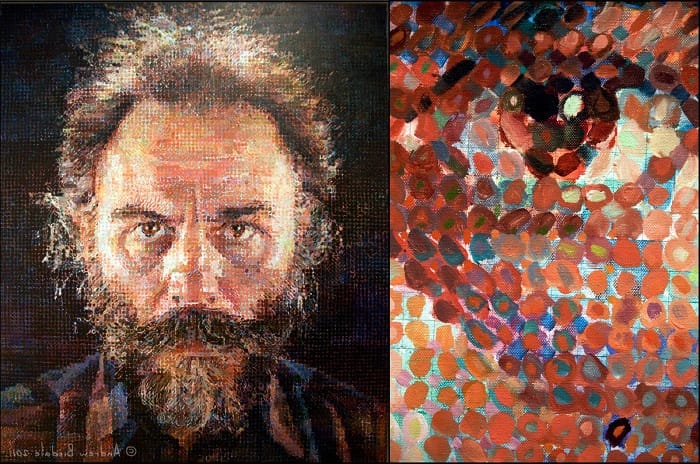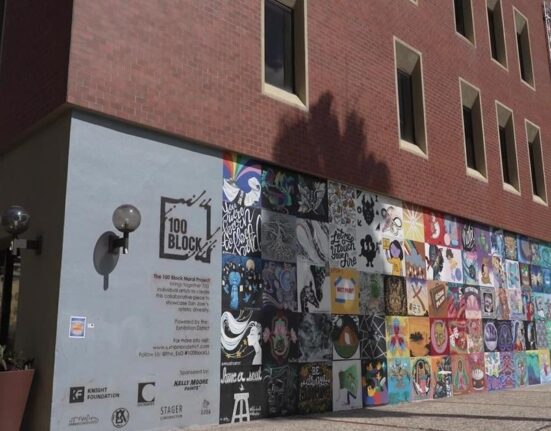Centering on the body and the psyche, Samaras’s autobiographical work across photography, painting, installation, assemblage, drawing, textile, and sculpture often meditates on the malleable, shapeshifting nature of selfhood. “I like remaking myself in photography,” the artist once said.
Samaras joined Pace’s program in 1965, and he had his first solo exhibition with the gallery at its West 57th Street space in New York in 1966. Since then, Pace has presented some 30 exhibitions dedicated to the artist’s work, including his 2022 show, Albums, at Pace’s New York flagship, which focused on his construction of an illustrated auto-historical archive through his Albums, each comprising hundreds of images. In 2023, Pace Publishing released a new volume focused on Samaras’s psychedelic, digital depictions of flowers. He also extended his practice into Web3 in recent years, producing a series of NFTs derived from psychedelic images he produced in the mid 2000s.
In September 2024, an exhibition featuring sculptures from the artist’s Cubes and Trapezoids series, which he created between 1993 and 1994, along with one of his immersive mirrored rooms, will go on view at Dia Beacon in New York.
Born in Kastoria, Greece in 1936, Samaras immigrated to the United States with his family in 1948, settling in West New York, New Jersey. He attended Rutgers University in New Jersey from 1955 to 1959, studying under artists Allan Kaprow and George Segal. Samaras also met fellow student Robert Whitman, an artist with whom he would collaborate in the years to come, at Rutgers. In 1959, he studied art history under Meyer Schapiro at Columbia University in New York.
Having crossed paths with these major figures in the city’s postwar art scene, Samaras soon became immersed in the theatrical, scrappy, madcap Happenings—a hybrid art form spanning installation, performance, and other mediums—staged on the Lower East Side in the late 1950s and early 1960s. In 1959, Samaras was included in Kaprow’s 18 Happenings in 6 Parts at the Reuben Gallery in New York, where he also presented his first-ever solo exhibition in the city that same year. Through his early associations with Kaprow and Whitman, he established himself as a leading figure in the Happenings alongside other figures like Claes Oldenburg, Jim Dine, and Red Grooms. This legendary movement, which is foundational in Pace’s institutional history, helped shape the history of art in the 20th and 21st centuries.
Even in these early years of his career—when he was beginning to cultivate his interest in investigations and depictions of the self—Samaras’s work eluded easy categorization within any single artistic movement or style. He created many of his self-portraits and figurations from this period using richly colored pastels, a material with which he could quickly work through his ideas about form and texture. The artist soon shifted his focus to assemblages, producing sculptural boxes and reliefs with miscellaneous materials—including cutlery, nails, mirrors, photographs, yarn, and feathers—affixed to one another with liquid aluminum or plaster. He debuted his assemblage boxes at Green Gallery in New York in 1961, the same year that he was included in The Art of Assemblage, a group exhibition at the Museum of Modern Art.
Five years later, Samara’s first solo exhibition with Pace featured works he had created between 1960 and 1966. Among the works in the show was his immersive Room No. 2 (1966), also known as Mirrored Room, which evolved from his assemblage boxes and became his first installation to enter a museum collection when it was acquired by the Albright-Knox Art Gallery in Buffalo, New York in 1966. The artist then mounted his first institutional solo exhibition at the Museum of Modern Art in New York in 1969, a presentation that was followed by his first international solo exhibition at the Kunstverein Museum in Hannover, Germany in 1970.
For his provocative Sittings series, which he produced between 1979 and 1980, Samaras photographed various prominent figures in the New York art world posing naked in his studio. His Poses series, created between 1983 and 2010, also comprises color portraits of the artist’s friends and colleagues, including Arne Glimcher, Cindy Sherman, David Byrne, Alex Katz, Agnes Gund, Alex Gartenfeld, and Jasper Johns, among many others.
Obtaining his first computer in 1996 and his first digital camera in 2002, the artist began utilizing Photoshop as a key tool in his image making practice. These technologies gave way to his famed Photofictions series in 2003, fragmented self-portraits and fantastical abstractions that were the subject of a solo exhibition at Pace in New York that same year. As early as 2005, Pace was hosting exhibitions of Samaras’s work displayed on computer screens installed within the gallery space, rather than physical prints hung on its walls.
Samaras’s XYZ series, which includes four bodies of work created between 2010 and 2012, exemplifies his longstanding investigations of form, color, space, and the expansive possibilities of image making. This series of psychedelic abstractions would become the basis for his first NFT project, released by Pace Verso, the gallery’s hub for integrated Web3 artworks, in 2021. In recent years, he has also worked with his iPhone camera to create new self- portraits in his home and studio in New York. Having devoted his career to charting new frontiers in photography and digital art, experimentation remained integral to Samaras’s practice up until the end of his life.
Samaras’s work can be found in major museum collections around the world, including the Metropolitan Museum of Art in New York; the Museum of Modern Art in New York; the Whitney Museum of American Art in New York; Dia Art Foundation in New York; the Hirshhorn Museum and Sculpture Garden in Washington, D.C.; the Walker Art Center in Minneapolis; the Art Institute of Chicago; the Los Angeles County Museum of Art; the San Francisco Museum of Modern Art; Tate in London; the National Gallery of Australia in Canberra; and the Iwaki City Art Museum in Japan.







